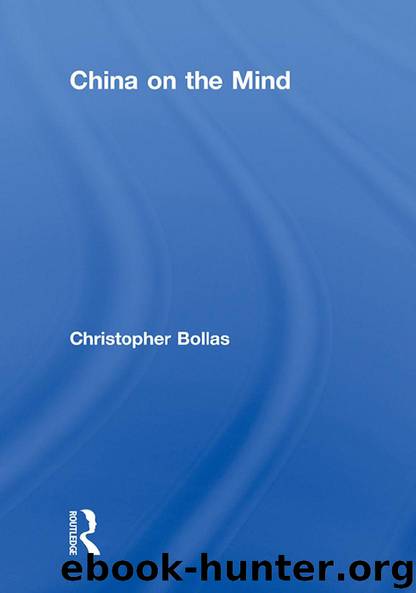China on the Mind by Christopher Bollas

Author:Christopher Bollas [Bollas, Christopher]
Language: eng
Format: epub
ISBN: 9781136182570
Publisher: Taylor and Francis
Published: 2012-11-26T23:00:00+00:00
Part Three
Conceptualizations
Chapter 8
Cultivation
In one of his final works, Exposition of the Vajrasamadhi-Sutra (Kumgang Sammaegyong Non, translated as Book of Adamantine Absorption),1 the great Korean commentator Wŏnhyo (617–686 CE) exhaustively outlines all the elements that go into human enlightenment. His work is far too complex for us to discuss here, but one of his lines of argument is directed towards the elimination of unproductive thought.
The Sutra postulates two fundamental states of mind: ‘the true-thusness’ (chinyo/zhenru) and ‘production-and-extinction’ (saengmyol/shengmie). Those who are misguided can find enlightenment through the abandoning of false ideas. Contemplation may aim at the destruction of delusion, but the deluded mind engaged in contemplation will continue to delude itself. ‘Consequently’ writes Wŏnhyo ‘one must annihilate all productions of mind. Therefore, the … approach of contemplation practice … elucidates the practice of nonproduction’. ‘Once one’s practice has stopped producing anything’, he continues, ‘one then experiences original enlightenment’.2
This idea brings to mind Winnicott’s theory of the elimination of the mind-as-false-self. Destruction of the false self requires the speaking self to be abandoned. Only then can the person return to a position in which the stirrings of the true self (original enlightenment) are possible. As discussed, in Playing and Reality3 Winnicott writes: ‘it is creative apperception more than anything else that makes the individual feel that life is worth living’, but he contrasts this with ‘the relationship to external reality [which] is one of compliance, the world and its details being recognized but only as something to be fitted in with or demanding adaptation’.4
Winnicott juxtaposes two features of mental life – the creatively apperceptive and the adaptive – and his psychoanalytic technique aims to suspend the adaptive work of the mind in order to provide a potential space for spontaneous creativity. When an analyst is quiet he does not impinge on the patient, especially if he suspends the demand for free association. Adaptation is unnecessary as nothing is expected. The adaptive mind (false self) therefore ceases to function and this, according to Winnicott, elicits a state of formlessness.
Although Winnicott only rarely makes an explicit challenge to other analytic stances (such as when claiming that he had learned to make few interpretations) he sets out a view of psychic change very different from any that preceded it, and, as we have seen, both his theory and his practice constitute a profound rejection of the verbal side of classical psychoanalytic tradition.
In Secrets on Cultivating the Mind,5 written between 1203 and 1205, the Korean Buddhist poet and philosopher, Chinul, tells us that, ‘if you want to become a Buddha, understand that Buddha is the mind’.6 His concept of mind is close to Winnicott’s true self, to some pure essence of being that precedes and authorizes human behaviour. Like Winnicott,7 he states that the original mind is formless – ‘This “formless thing” is the dharma-seal of all the Buddhas; it is your original mind’.8 Although there are two paths to spiritual enlightenment – sudden awakening and gradual cultivation – the aim is to achieve ‘numinous awareness’, a mind that is ‘pure, void, and calm’.
Download
This site does not store any files on its server. We only index and link to content provided by other sites. Please contact the content providers to delete copyright contents if any and email us, we'll remove relevant links or contents immediately.
Rewire Your Anxious Brain by Catherine M. Pittman(17589)
Talking to Strangers by Malcolm Gladwell(11876)
The Art of Thinking Clearly by Rolf Dobelli(8841)
Mindhunter: Inside the FBI's Elite Serial Crime Unit by John E. Douglas & Mark Olshaker(7834)
Becoming Supernatural by Dr. Joe Dispenza(7105)
Change Your Questions, Change Your Life by Marilee Adams(6641)
Nudge - Improving Decisions about Health, Wealth, and Happiness by Thaler Sunstein(6633)
The Road Less Traveled by M. Scott Peck(6633)
The Lost Art of Listening by Michael P. Nichols(6472)
Enlightenment Now: The Case for Reason, Science, Humanism, and Progress by Steven Pinker(6405)
Win Bigly by Scott Adams(6311)
Mastermind: How to Think Like Sherlock Holmes by Maria Konnikova(6235)
The Way of Zen by Alan W. Watts(5798)
Daring Greatly by Brene Brown(5639)
Grit by Angela Duckworth(4735)
Big Magic: Creative Living Beyond Fear by Elizabeth Gilbert(4723)
Men In Love by Nancy Friday(4320)
Flow by Mihaly Csikszentmihalyi(4052)
The Four Tendencies by Gretchen Rubin(4024)
